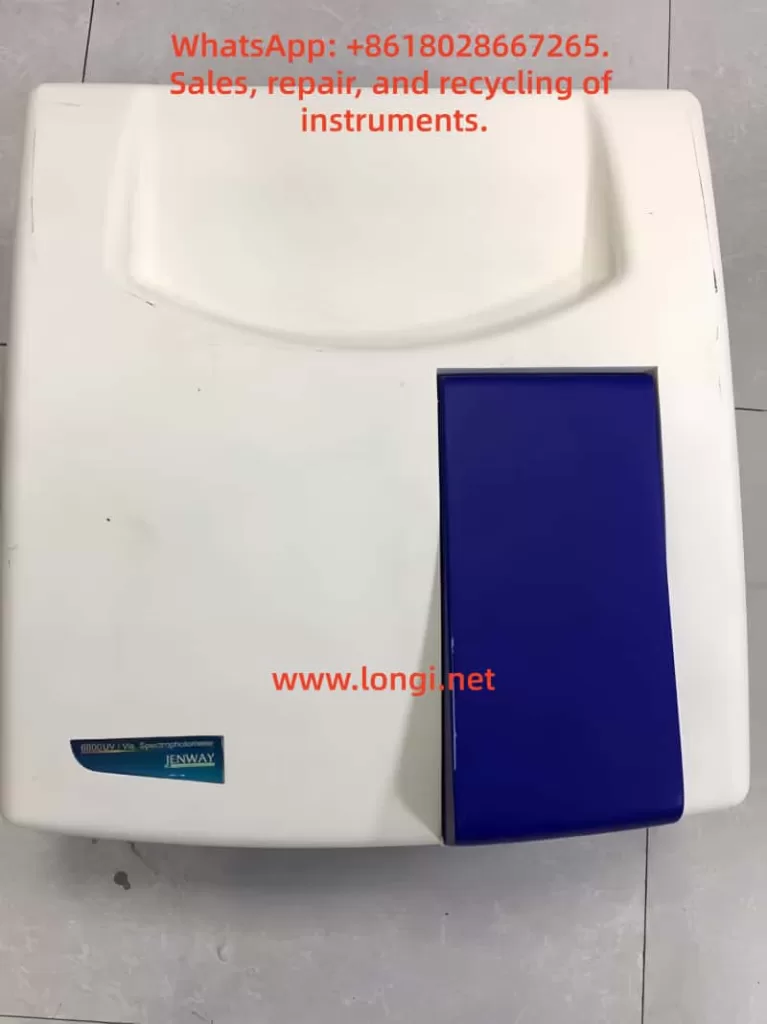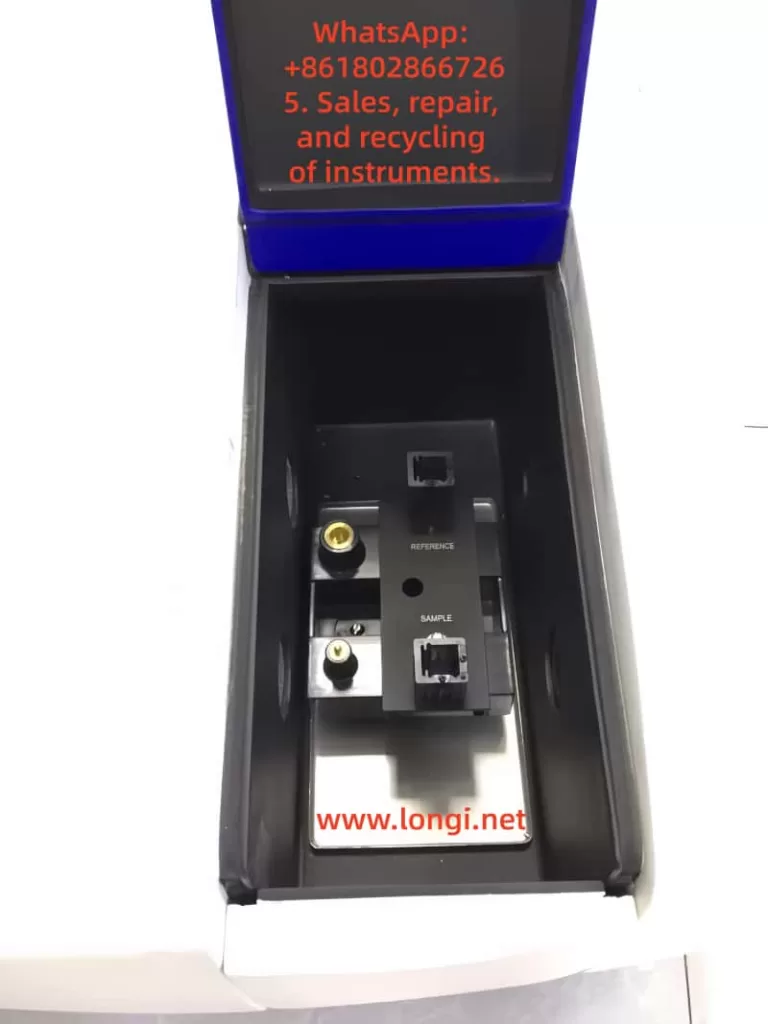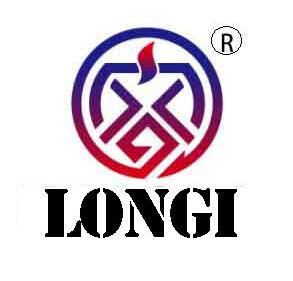I. Brand and Instrument Overview
Brand: Jenway (now part of the Cole-Parmer Group)
Instrument Model: Model 6800 Dual-Beam UV/Visible Spectrophotometer
Application Areas: Laboratory environments such as education, quality control, environmental analysis, and clinical analysis
Core Features:
- Dual-Beam Design: Enhances optical stability and measurement accuracy.
- Wide Wavelength Range: 190-1100nm, covering the ultraviolet to near-infrared spectrum.
- Multifunctional Modes: Supports photometric measurements, multi-wavelength scanning, kinetic analysis, quantitative determination, and specialized protein/nucleic acid detection.
- Modular Accessories: Compatible with various sample holders, including microplates, long-path cuvettes, and temperature-controlled circulation cells.

II. Core Content Analysis of the Operation Manual
1. Safety and Installation Specifications
Safety Warnings:
- Only trained personnel should operate the instrument. Avoid contact with high-voltage components.
- The operating environment should be free of corrosive gases, with a stable temperature (10-35°C) and humidity (45-85%).
- Do not disassemble non-user-serviceable parts, as this will void the warranty.
Installation Steps:
- Remove the light source protective foam after unpacking.
- Use two people to lift the 27kg main unit to avoid dropping it.
- Power requirements: 110-240V AC, grounded, and with stable voltage.
2. Software System Configuration
Flight Deck Software Installation:
- Compatible with Windows 2000/XP/Vista, requiring a 1GHz CPU, 256MB RAM, and 500MB of hard disk space.
- Install via CD, with the default installation path set to C:\Program Files\FlightDeck. A desktop shortcut is created after installation.
Instrument Connection:
- Use an RS232 serial port or USB adapter to communicate with the computer.
- Complete a self-check (approximately 1 minute) upon first startup.
3. Basic Operation Procedures
3.1 Photometric Measurement Mode (Photometrics)
Steps:
- Parameter Settings: Select ABS/%T/Energy mode and set the wavelength (1-6 wavelengths).
- Blank Calibration: Insert the blank solution and click “Blank Calibration” to automatically zero.
- Sample Measurement: Replace with the sample to be tested and click “Measure” to record the data.
- Data Processing: Supports export to Excel and can calculate absorbance ratios or differences.
3.2 Spectrum Scan Mode (Spectrum Scan)
Key Parameters:
- Scan Speed: 10-3600nm/min.
- Baseline Correction: Option for system baseline or user-defined baseline.
Advanced Features:
- Peak/Valley Detection: Adjust detection accuracy via threshold and sensitivity settings.
- Derivative Spectrum: Generate second-derivative spectra with one click.
3.3 Quantitative Analysis (Quantitation)
Calibration Curve: Supports 1-100 standard samples, with options for linear, quadratic, or piecewise fitting.
Example: For protein concentration determination, pre-stored calibration curves can be imported.
Path Correction: Applicable to non-10mm pathlength cuvettes, with automatic absorbance conversion by the software.

4. Specialized Application Modules
4.1 Nucleic Acid Analysis (DNA/RNA)
Calculation Formulas:
- Concentration (μg/mL): = A260 × Conversion Factor (50 for dsDNA, 40 for RNA).
- Purity Assessment: A260/A280 ratio.
Notes: Enable A320 correction to eliminate turbidity interference.
4.2 Protein Detection
Method Selection:
- Bradford Method: Detection at 595nm.
- Lowry Method: Detection at 750nm.
- Direct UV Method: Utilizes tyrosine absorption at 280nm without staining.
Data Export: Supports generation of statistical reports with SD and CV.
5. Accessory Operation Guide
Temperature-Controlled Water Bath Cuvette Holder:
- Remove the original holder and install the circulation water interface.
- Set the water temperature and connect to an external temperature-controlled water bath.
- Introduce dry gas to prevent condensation.
Micro-Volume Cuvette (50μL):
- Use a dedicated holder, avoid bubbles during filling, and correct the pathlength to 10mm.
III. Maintenance and Troubleshooting
1. Daily Maintenance
Cleaning:
- Sample Chamber: Wipe the window with isopropyl alcohol.
- Cuvettes: Soak quartz cuvettes in hydrofluoric acid (for stubborn stains only); do not reuse plastic cuvettes.
Light Source Replacement:
- Tungsten Lamp: Allow to cool for 20 minutes before replacement and reset the usage time.
- Deuterium Lamp: Wear gloves and avoid touching the quartz window.
2. Common Issues
- Baseline Drift: Check temperature stability or re-execute baseline correction.
- Inaccurate Wavelength: Calibrate using the built-in holmium glass filter.
- Communication Failure: Check the RS232 port configuration.
IV. Technical Parameter Quick Reference Table
| Item | Parameter Value |
|---|---|
| Wavelength Accuracy | ±0.3nm |
| Photometric Accuracy | ±0.002A (0-0.5A range) |
| Stray Light | <0.05% (at 220nm) |
| Dimensions | 540×560×235mm |
V. Original Usage Recommendations
Method Development Tips:
- For high-concentration samples, use the “dilution factor” function to calculate the original concentration.
- When performing multi-wavelength scans, enable “multi-file overlay” to compare samples from different batches.
Data Management:
- Establish standardized naming conventions (e.g., “date_sample name_wavelength”) for easy traceability.
Compliance:
- Regularly perform IQ/OQ validation (templates provided in the operation manual appendix).
Technical Support:
- For further assistance, contact the Cole-Parmer official technical service team for customized solutions.
